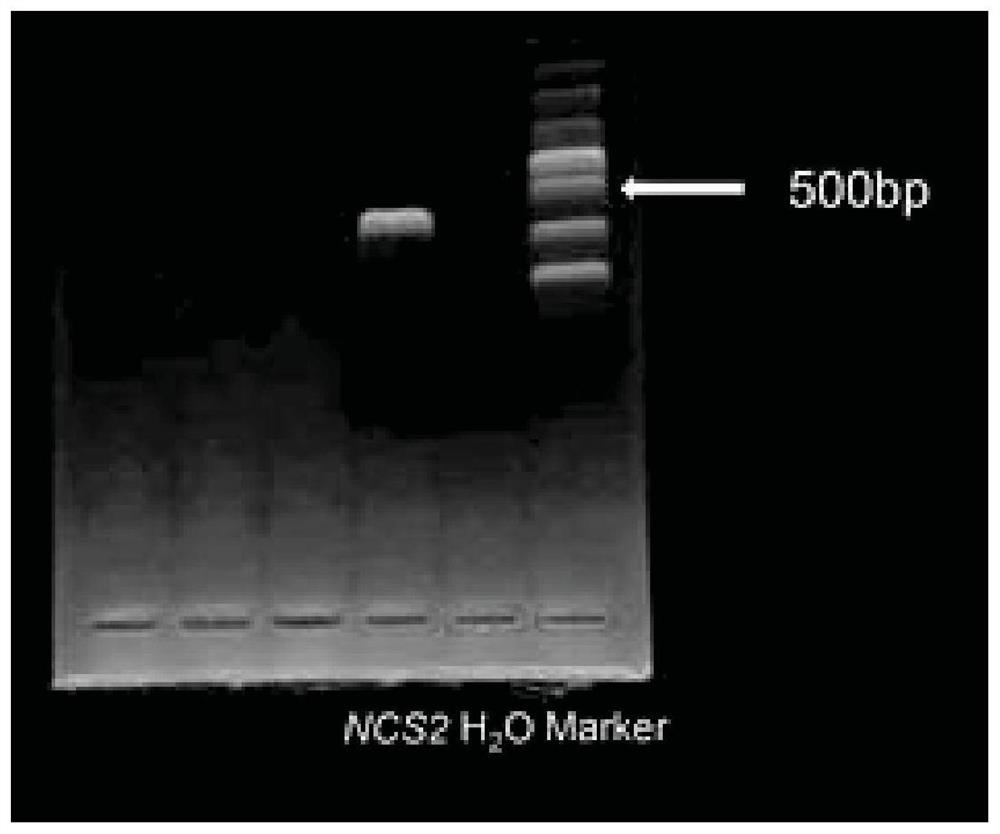Application of nilaparvata lugens NCS2 gene or encoded protein as target spot in preparation of medicine for preventing and treating nilaparvata lugens
A brown planthopper, gene technology, applied in the application, genetic engineering, plant genetic improvement and other directions, can solve the problems of aggravating environmental pollution and stimulating the reproduction of pests, and achieve the effects of inhibiting reproduction, inhibiting individual development, inhibiting growth and reproduction.
- Summary
- Abstract
- Description
- Claims
- Application Information
AI Technical Summary
Problems solved by technology
Method used
Image
Examples
Embodiment 1
[0026] Rice pest brown planthopper NCS2 gene.
[0027] Step 1: Extraction of total RNA from N. lugens and cloning of NCS2 gene
[0028] The adult N. lugens (100 mg) was placed in a grinding tube, an appropriate amount of silica grinding beads and 1 mL of Trizol reagent were added, and the tissue grinder was shaken and ground three times at 60 Hz for 30 seconds each time, and stood on ice for 3 minutes. The sample was centrifuged at 12,000 rpm and 4°C for 10 minutes, and 800 μL of the supernatant was transferred to a new 1.5 mL RNase free EP tube; 500 μL of chloroform was added, vigorously shaken for 30 seconds, and allowed to stand at room temperature for 3 minutes. Centrifuge at 12000rpm, 4°C for 10 minutes, pipette the supernatant into a new 1.5mL RNase freeEP tube, add an equal volume of isoacetone, gently invert and mix for 30 seconds, and let stand at room temperature for 20 minutes. Centrifuge at 12,000 rpm, 4°C for 20 minutes, a precipitate can be seen at the bottom of...
Embodiment 2
[0044] 1. Synthesis of dsRNA
[0045] The following specific primers containing the T7 promoter were used:
[0046] Forward:
[0047]
[0048] Reverse:
[0049]
[0050] The underlined sequence is the T7 promoter sequence.
[0051] dsGFP primer sequences are as follows
[0052] dsGFP-F:
[0053]
[0054] dsGFP-R:
[0055]
[0056] Using the recombinant plasmid pMD-NCS2 extracted in Example 1 as a template, a high-concentration DNA fragment of about 550 bp was amplified by PCR with the above-mentioned primers (the nucleotide sequence is shown in SEQ ID NO. 4), and this was used as a template. Synthesize dsNCS2 (the nucleotide sequence of the sense strand is shown in SEQ ID NO.3, and the nucleotide sequence of the antisense strand is the reverse complement of the sequence shown in SEQ ID NO.3), and the template synthesized by dsGFP is a well-known sequence .
[0057] Prepare the double-stranded RNA synthesis reaction system:
[0058] ATP solution, UTP solutio...
PUM
 Login to View More
Login to View More Abstract
Description
Claims
Application Information
 Login to View More
Login to View More - R&D
- Intellectual Property
- Life Sciences
- Materials
- Tech Scout
- Unparalleled Data Quality
- Higher Quality Content
- 60% Fewer Hallucinations
Browse by: Latest US Patents, China's latest patents, Technical Efficacy Thesaurus, Application Domain, Technology Topic, Popular Technical Reports.
© 2025 PatSnap. All rights reserved.Legal|Privacy policy|Modern Slavery Act Transparency Statement|Sitemap|About US| Contact US: help@patsnap.com



